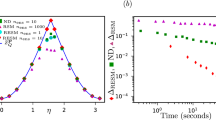Abstract
The score operators of a quantum system are the symmetric logarithmic derivatives of the system’s parametrically defined quantum state. Score operators are central to the calculation of the quantum Fisher information (QFI) associated with the state of the system, and the QFI determines the maximum precision with which the state parameters can be estimated. We give a simple, explicit expression for score operators of a qubit and apply this expression in a series of settings. We treat in detail the task of identifying a quantum Pauli channel from the state of its qubit output, and we show that a “balanced” probe state is highly robust for this purpose. The QFI for this task is a matrix, and we study its determinant, for which we establish a Cramér-Rao inequality.
Similar content being viewed by others
References
Fano U.: Description of states in quantum mechanics by density matrix and operator techniques. Rev. Mod. Phys. 29(1), 74–93 (1957)
D’Ariano G.M., Paris M.G.A., Sacchi M.F.: Quantum tomographic methods. In: Paris, M.G.A., Řeháček, J. (eds) Quantum State Estimation, Springer, Berlin (2004)
Altepeter J.B., James D.F.V., Kwiat P.G.: Qubit quantum state tomography. In: Paris, M.G.A., Řeháček, J. (eds) Quantum State Estimation, Springer, Berlin (2004)
Helstrom C.W.: Quantum Detection and Estimation Theory. Academic Press, New York (1976)
Holevo A.S.: Probabilistic and Statistical Aspects of Quantum Theory. North-Holland Publishing, Amsterdam (1982)
Braunstein S.L., Caves C.M.: Statistical distance and the geometry of quantum states. Phys. Rev. Lett. 72(22), 3439–3443 (1994)
Paris M.G.A.: Quantum estimation for quantum technology. Int. J. Quantum Inf. 5, 125–137 (2009)
van Trees H.L.: Detection, Estimation, and Modulaiton Theory, Part I. Wiley, New York (2001)
Frey M.R., Collins D.: Quantum Fisher information and the qudit depolarization channel. In: Donkor, E.J., Pirich, A.R., Brandt, H.E. (eds) Quantum Information and Computing VII, SPIE 7342, Orlando, Florida (2009)
Fujiwara A.: Quantum channel identification problem. Phys. Rev. A 63, 042304 (2001)
Petz D.: Quantum Information Theory and Quantum Statistics. Springer, Berlin (2008)
Johnson R.A., Wichern D.W.: Applied Multivariate Statistical Analysis, 6th edn. Pearson Prentice Hall, Upper Saddle River (2007)
Horn R.A., Johnson C.R.: Matrix Analysis. Cambridge University Press, Cambridge (1990)
Fujiwara A.: Estimation of a generalized amplitude-damping channel. Phys. Rev. A 70, 012317 (2004)
Frey M.R., Coffey L.E., Mentch L.K., Miller A.L., Rubin S.S.: Pauli channels exhibit a transition effect in memory estimation above a parametric threshold. In: Donkor, E.J., Pirich, A.R., Brandt, H.E. (eds) Quantum Information and Computing VIII, SPIE, Orlando, Florida (2010)
Fujiwara A., Imai H.: Quantum parameter estimation of a generalized Pauli channel. J. Phys. A: Math. Gen. 36, 8093–8103 (2003)
Bickley W.G., McNamee J.: Matrix and other direct methods for the solution of systems of linear difference equations. Philos. Trans. R. Soc. Lond. A 252(1005), 69–131 (1960)
Slater P.B.: Applications of quantum and classical Fisher information to two-level complex and quaternionic and three-level complex systems. J. Math. Phys. 37(6), 2682–2693 (1995)
Boixo S., Monras A.: Operational interpretation for global entanglement. Phys. Rev. Lett. 100, 100503 (2008)
Fischer D.G., Mack H., Cirone M.A., Freyburger M.: Enhanced estimation of a noisy quantum channel using entanglement. Phys. Rev. A 64, 022309 (2001)
Harville D.A.: Matrix Algebra from a Statistician’s Perspective. Springer, New York (1997)
Daems D.: Entanglement-enhanced transmission of classical information in Pauli channels with memory: exact solution. Phys. Rev. A 76, 012310 (2007)
Hradil Z., Řeháček J., Fiurášek J., Ježek M.: Maximum-likelihood methods in quantum mechanics. In: Paris, M.G.A., Řeháček, J. (eds) Quantum State Estimation, Springer, Berlin (2004)
Author information
Authors and Affiliations
Corresponding author
Rights and permissions
About this article
Cite this article
Frey, M.R., Miller, A.L., Mentch, L.K. et al. Score operators of a qubit with applications. Quantum Inf Process 9, 629–641 (2010). https://doi.org/10.1007/s11128-010-0170-5
Received:
Accepted:
Published:
Issue Date:
DOI: https://doi.org/10.1007/s11128-010-0170-5



